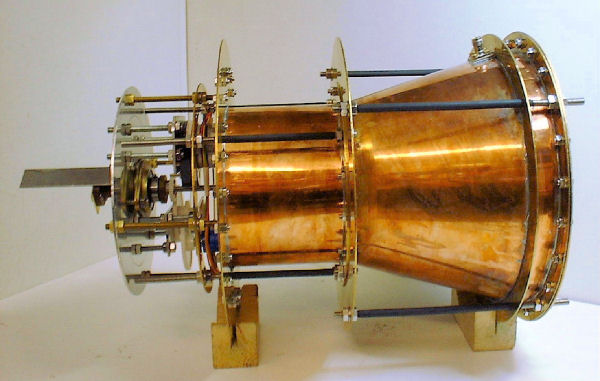No Fuel Needed: NASA Successfully Tested EM Drive
| Marco Foronda | | May 04, 2015 09:06 AM EDT |
(Photo : Roger Sawyer) The concept of an EmDrive engine is relatively simple. It provides thrust to a spacecraft by bouncing microwaves around in a closed container.
NASA’s Johnson Space Center has been successfully tested a electromagnetic (EM) propulsion drive.
NASA Eagleworks – an advanced propulsion research group led by Dr. Harold “Sonny” White at the Johnson Space Center (JSC) – caused a stir in the scientific community last summer by presenting their results on July 28-30, 2014, at the 50th AIAA/ASME/SAE/ASEE Joint Propulsion Conference in Cleveland, Ohio.
Like Us on Facebook
With this breakthrough research, the scientists at NASA were able to successfully test EM propulsion in a hard vacuum for the very first time, whereas previous tests were channeled in atmospheric conditions.
Defying the Newtonian Law of Physics, the Newton’s Law of Conservation of Momentum has been defied, as the EM drive was prolifically carried out in a closed cavity.
The concept of EM Drive came into picture in 2001 when a Research and Development (R&D) program was started by a small UK company, Satellite Propulsion Research Ltd (SPR),
Electromagnetic microwave cavities provide a way for directly converting electrical energy to thrust without relying on the need to expel any propellant.
British, American and Chinese space programs scientist, have all been investigating procedures to utilize electromagnetic microwaves to enable production of electrical energy which can be directly converted into thrust.
Dr. White clarified that the propellant expulsion is not inevitably needed to balance the change in the momentum of the spacecraft.
“EM Drive’s thrust was due to the Quantum Vacuum behaving like propellant ions behave in a Magneto Hydro Dynamics drive for spacecraft propulsion,” he added.
This space domain breakthrough of travel has unlocked fresh possibilities of using as a fuel source, an alternative; virtual particles of quantum vacuum, thereby, eradicating the burdensome need of propellant usage.
Since 2001, NASA’s Eagleworks propulsion research group has been working to invent a device that can function in such a closed cavity for electrical energy conversion to be put into motion, without fuel requirement.
TagsNo Fuel Needed: NASA Successfully Tested EM Drive, EM drive, no fuel space travel, space travel, NASA, space exploration
©2015 Chinatopix All rights reserved. Do not reproduce without permission
EDITOR'S PICKS
-

Did the Trump administration just announce plans for a trade war with ‘hostile’ China and Russia?
-

US Senate passes Taiwan travel bill slammed by China
-

As Yan Sihong’s family grieves, here are other Chinese students who went missing abroad. Some have never been found
-

Beijing blasts Western critics who ‘smear China’ with the term sharp power
-

China Envoy Seeks to Defuse Tensions With U.S. as a Trade War Brews
-

Singapore's Deputy PM Provides Bitcoin Vote of Confidence Amid China's Blanket Bans
-

China warns investors over risks in overseas virtual currency trading
-

Chinese government most trustworthy: survey
-

Kashima Antlers On Course For Back-To-Back Titles
MOST POPULAR
LATEST NEWS
Zhou Yongkang: China's Former Security Chief Sentenced to Life in Prison

China's former Chief of the Ministry of Public Security, Zhou Yongkang, has been given a life sentence after he was found guilty of abusing his office, bribery and deliberately ... Full Article
TRENDING STORY

China Pork Prices Expected to Stabilize As The Supplies Recover

Elephone P9000 Smartphone is now on Sale on Amazon India

There's a Big Chance Cliffhangers Won't Still Be Resolved When Grey's Anatomy Season 13 Returns

Supreme Court Ruled on Samsung vs Apple Dispute for Patent Infringement

Microsoft Surface Pro 5 Rumors and Release Date: What is the Latest?










